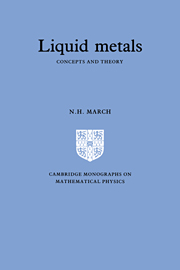Book contents
- Frontmatter
- Contents
- Preface
- 1 Outline
- 2 Pair correlation function and structure factor of ions
- 3 Thermodynamics
- 4 Electron screening and effective ion-ion interactions
- 5 Interionic forces and structural theories
- 6 Statistical mechanics of inhomogeneous systems and freezing theory
- 7 Electronic and atomic transport
- 8 Hydrodynamic limits of correlation functions and neutron scattering
- 9 Critical behaviour
- 10 Electron states, including critical region
- 11 Magnetism of normal and especially of expanded liquid metals
- 12 Liquid-vapour surface
- 13 Binary liquid-metal alloys
- 14 Two-component theory of pure liquid metals
- 15 Shock-wave studies
- 16 Liquid hydrogen plasmas and constitution of Jupiter
- Appendices
- References
- Index
14 - Two-component theory of pure liquid metals
Published online by Cambridge University Press: 19 January 2010
- Frontmatter
- Contents
- Preface
- 1 Outline
- 2 Pair correlation function and structure factor of ions
- 3 Thermodynamics
- 4 Electron screening and effective ion-ion interactions
- 5 Interionic forces and structural theories
- 6 Statistical mechanics of inhomogeneous systems and freezing theory
- 7 Electronic and atomic transport
- 8 Hydrodynamic limits of correlation functions and neutron scattering
- 9 Critical behaviour
- 10 Electron states, including critical region
- 11 Magnetism of normal and especially of expanded liquid metals
- 12 Liquid-vapour surface
- 13 Binary liquid-metal alloys
- 14 Two-component theory of pure liquid metals
- 15 Shock-wave studies
- 16 Liquid hydrogen plasmas and constitution of Jupiter
- Appendices
- References
- Index
Summary
In this chapter we shall report on developments in liquid-metal theory in which, instead of dealing with ions coupled by effective interactions mediated by the conduction electrons, the liquid metal is treated as a two-component system, conduction electrons and positive ions (Cowan and Kirkwood, 1958; Watabe and Hasegawa, 1973; Chihara, 1973; March and Tosi, 1973). Earlier, evidence has been presented for well-defined collective modes of the positive ions in liquid Rb near its melting point. There is, of course, no doubt that, in any dense assembly of conduction electrons, there are well-defined plasma modes. Therefore, a workable model to keep in mind for such a two-component system begins with the assumption that there are two types of well-defined collective excitations; density fluctuations (analogous to phonons in a crystal) and plasmons (Tosi and March, 1973a; for details see Appendix 14.1).
Following the approach of March and Tosi (1973), the two-component theory will be developed in terms of three partial structure factors, Sii = S, the nuclear-nuclear structure factor as observed by neutron scattering, the electron-electron structure factor See, and the “cross” correlations represented by Sie(k).
Electron-ion Hamiltonian and density fluctuation operators
To implement the programme just outlined, let us set up a description of the liquid metal in terms of the local number densities ρe(r, t) and ρi(r, t) of electrons and ions, respectively, at position r and time t.
- Type
- Chapter
- Information
- Liquid MetalsConcepts and Theory, pp. 260 - 302Publisher: Cambridge University PressPrint publication year: 1990



